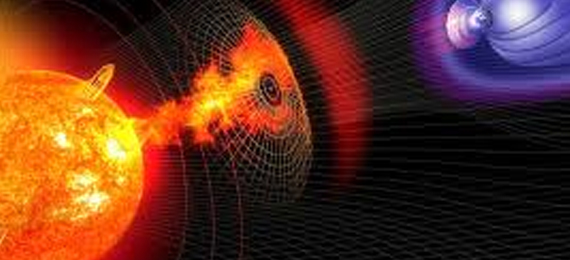
Is there weather in space? If no, then what is space weather? What are the types of space weather? And how does space weather affect the Earth? This article might help you discover several interesting facts about space weather.
What Is Space Weather?
Space Weather indicates several processes on the Sun and in space that might affect human activities with the technology.
History of Space Weather
The concept of space weather was identified in the Carrington Event 1859. It was an effort of two astronomers including Richard Carrington who observed a solar flare followed by a solar storm reaching the regions of Earth’s magnetic field. This was soon overloaded with charged particles. As a result of this, aurora activity was intense allowing the northern lights to be visible near the poles. The light was so bright that some people woke up in the night thinking it was daylight.
How Fast Do Solar Flares Travel?
- A. 400 Miles Per Second
- B. 600 Miles Per Second
- C. 800 Miles Per Second
- D. 1000 Miles Per Second
The 1859 solar storm occurred when a new technology called the telegraph system was introduced in the US and a few other countries. It works by sending messages in code through electrical wires. The charged particles affected the wires of the telegraph system leading to light sparks from the wires. This is when scientists speculated a connection between the solar activities and Earth and led to the basic understanding of space weather.
Types of Space Weather Storms:
-
Radio Blackouts
These are usually caused by bursts of Extreme Ultraviolet radiation and X-rays that are emitted from solar flares. High Frequency (HF) communications are usually affected. This is one of the most common types of space weather events that affect the Earth. Since the traveling speed from the Sun to the Earth is just 8 minutes, advance warnings are difficult. Aviation and marine industries are usually affected as they rely on HF radio communications.
-
Solar Radiation Storms
Solar Radiation storms usually occur when the charged particles such as protons and electrons are accelerated near the Sun. Their impacts include HF radio communications through the polar regions, damage to satellite systems, etc.
-
Geomagnetic Storms
Geomagnetic storms usually have a huge impact on technological systems and critical infrastructures. They might last a few hours to days. Many electric power companies have procedures in order to mitigate the impact of these Geomagnetic storms.
How does the sun contribute to space weather? Solar activities associated with space weather can be divided into four main components: solar flares, coronal mass ejections, high-speed solar wind, and solar energetic particles. The Sun is a million times larger than the Earth, therefore the electromagnetic radiation takes around 8 minutes to move from the Sun to the Earth, while the charged particles take a few hours to days to move from the Sun to the Earth.
Solar flares, coronal mass ejections, coronal holes, high-speed solar wind, and solar energetic particles are the major solar activities that are responsible for most of the space weather we experience.
What Are Coronal Holes?
Coronal holes are regions where high-speed streams of plasma flow out from the Sun. As it reaches the Earth, the magnetosphere contracts, and once the solar wind travels by, it expands. This causes mild electromagnetic disturbances on Earth.
What Are Solar Flares?
The sun releases electromagnetic waves on the Earth’s upper atmosphere in the form of X-rays, energetic particles, and intense ultraviolet radiation. The atoms present in the upper atmosphere of the Earth are ionized by these X-rays and ultraviolet radiation. Therefore, the freed electrons build up a charge on the surface of a spacecraft. These events might last from ½ hour to 3 hours. The solar flares are considered more serious compared to the coronal holes.
- CMEs with class C flares only lead to little effect on the Earth
- CMEs with class M flares lead to minor geomagnetic storms.
- CMEs with class X flares might lead to major geometric storms.
What Is Coronal Mass Ejection(CME)?
Coronal Mass Ejections(CMEs) are gigantic bubbles that contain a huge amount of electrified gas blown away from the sun into space. They can have numerous effects on the Earth. The CME reaches Earth a few days after leaving the sun, then it heats the ionosphere allowing it to expand farther into space. Therefore, the friction between the atmosphere and spacecraft increases, dragging down the satellites to lower altitudes. This mass might also affect HF radio communication.
In March 1989, a strong flare and CME occurred allowing the system to lose track of 11,000 objects orbiting Earth from the 19,000 ones. This occurred due to the expansion of the Earth’s atmosphere. Later, many satellites are brought to low altitudes and are destroyed by friction with the atmosphere.
These satellites must be amplified to higher altitudes in order to remain in orbit.
How Does Space Weather Affect Earth?
- Geomagnetic storms might affect the power lines. Many power companies use specific research conducted by Natural Resources Canada to improve their operating procedures in order to minimize the disturbances.
- The pipelines are usually coated with corrosion protection devices in order to minimize corrosion. Geomagnetic storms also affect the pipelines. Monitoring the performance of the protective devices might help reduce the risk.
- The energetic particles produced during the geomagnetic storm enter the ionosphere, ionizing molecules to form electrons and positive ions. The ionosphere absorbs instead of reflecting due to the increased number of electrons at lower altitudes. Therefore the radio signals become weak disrupting radio communications in the Arctic.